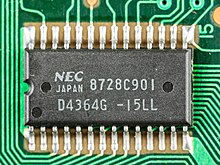
Back RAM-CMOS Catalan CMOS-RAM German RAM-CMOS Spanish حافظه غیرفرار بایوس Persian Baterai CMOS ID 비휘발성 바이오스 메모리 Korean RAM-CMOS Portuguese Энергонезависимая память BIOS Russian Напівпостійна пам'ять BIOS Ukrainian غیر متزلزل بایوس میموری Urdu
This article may need to be rewritten to comply with Wikipedia's quality standards. (May 2021) |


Nonvolatile BIOS memory refers to a small memory on PC motherboards that is used to store BIOS settings. It is traditionally called CMOS RAM because it uses a volatile, low-power complementary metal–oxide–semiconductor (CMOS) SRAM (such as the Motorola MC146818 or similar) powered by a small "CMOS" battery when system and standby power is off.[1] It is referred to as non-volatile memory or NVRAM because, after the system loses power, it does retain state by virtue of the CMOS battery.
The CMOS RAM and the real-time clock have been integrated as a part of the southbridge chipset and it may not be a standalone chip on modern motherboards.[2][3] In turn, the southbridge have been integrated into a single Platform Controller Hub.
The chipset built-in NVRAM capacity is typically 256 bytes.[2] For this reason, later BIOS implementations may use a small portion of BIOS flash ROM as NVRAM, to store setup data.[4]
Today's UEFI motherboards use NVRAM to store configuration data (NVRAM is a portion of the UEFI flash ROM), but by many OEMs' design, the UEFI settings are still lost if the CMOS battery fails.[5][6]
- ^ Fisher, Tim. "What is CMOS? (CMOS & CMOS Battery Definition)". About.com. Archived from the original on 9 August 2016. Retrieved 2 September 2015.
- ^ a b "Intel 100 Series Chipset Family PCH Datasheet". Intel. August 2015. Retrieved 16 April 2016.
- ^ "82430FX PCISET Data Sheet" (PDF). Intel. Retrieved 23 January 2023.
- ^ http://rom.by/files/AMIBIOS8-Flash-Recovery-Whitepaper.pdf
- ^ "UEFI NVRAM - OSDev Wiki". wiki.osdev.org. Retrieved 11 September 2020.
- ^ Yao, Jiewen; Zimmer, Vincent (2020). "Firmware Resiliency: Detection". Building Secure Firmware. pp. 115–162. doi:10.1007/978-1-4842-6106-4_4. ISBN 978-1-4842-6105-7. S2CID 242541772.
© MMXXIII Rich X Search. We shall prevail. All rights reserved. Rich X Search